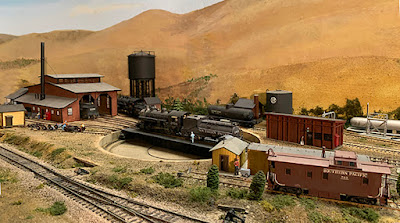My layout of a fictitious Southern Pacific branch line was designed to have, as was SP practice, an engine terminal for the branch power. I have posted about my engine servicing facilities at the town of Shumala from the earliest days of this blog. For a look at those facilities in a fairly primitive state, see this post: https://modelingthesp.blogspot.com/2011/04/modeling-engine-terminal.html .
A few years later, I had built the excellent Banta Modelworks kit for the Port Costa SP roundhouse to go with my Diamond Scale turntable, and had added a caboose servicing building. I posted an update about the facilities to describe the changes; see: https://modelingthesp.blogspot.com/2016/01/shumala-engine-terminal-update.html .
I also wrote an article for Model Railroad Hobbyist about engine
servicing, which was in the issue for August 2017; that issue is still
available to read on line or download, for free, at www.mrhmag.com . Many of my engine service details are shown in up-close views in that article.
Then two years ago, when I had increased the detailing around the fuel and water columns of the service area, and added a scratchbuilt sand house and refined other details, I posted another update (it’s available at: https://modelingthesp.blogspot.com/2022/01/modeling-engine-servicing.html ). Here’s a view looking across the turntable toward the roundhouse, with the caboose service track in the foreground.
One relatively new feature in these facilities is a storage tank for diesel fuel. Since a diesel switcher is normally used at Shumala, this would be expected. I’ve now added it. It’s the silver tank shown below, just to the left of the sand house (the turntable pit is in the foreground). The large black tank is for steam locomotive Bunker C oil. In front of the tank are duckboards (see: https://modelingthesp.blogspot.com/2015/08/duckboards.html ).
Some time back I added a kind of “mini-scene” on a stub track off the turntable, to illustrate changing out a wheelset in a freight truck. This was part of another Model Railroad Hobbyist article about prototype trucks and wheels, in September 2016; this one too is still available for free.
In the view below, the scene shows a new wheelset being rolled into position to be placed in the truck. The removed wheelsets, with shiny wheel treads, are already moved out of the way. In the left background are shown a couple of truck bolsters and a stack of side frames (note the prototypical small kingpin center holes in the bolsters). This was set up temporarily, to photograph for the article, but I liked it and have left it in place.
Lastly, the track that you see just above the wheelset scene (above) is a track that serves the machine shop on the back of the roundhouse (see: https://modelingthesp.blogspot.com/2016/03/a-shop-track-for-shumala.html ). This allows me to set up varying scenes of parts deliveries to the roundhouse; machinery deliveries to the shop; inbound or outbound loads of wheels; and other interesting scenes.
Here’s a load of new wheels arriving in a gondola, presumably for the roundhouse machine shop to complete wheel tread contours and press onto axles.
Another possibility (to choose just one alternative for illustration) is unloading something like machine tools from a flat car, at the machine shop loading dock. That’s shown below, and as with the scenes shown above, is readily changed. I originally tried to show a tarpaulin partly off one of the machines, but couldn’t make it look right to my eyes. (You can click on the image to enlarge it.)
All in all, I feel like my engine terminal facilities are complete at this point, and they serve what is needed as I wanted them to do.
Tony Thompson





I know you stained your engine house a box car red. What product did you use?
ReplyDeleteI used some old Floquil, well thinned, and wiped it on with a piece of cloth.
DeleteTony Thompson
For your tarp, perhaps some very thin micro-fiber cloth would work. I find that it can be poked and prodded to hang more naturally than conventional cloth or tissue.
ReplyDelete